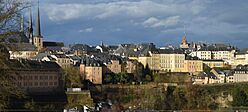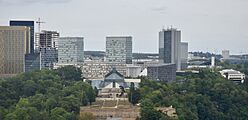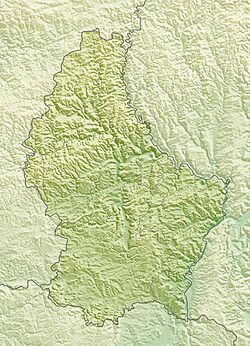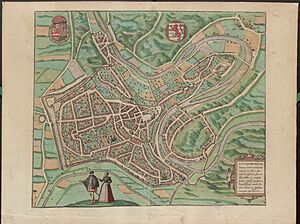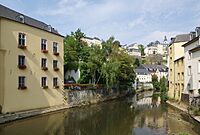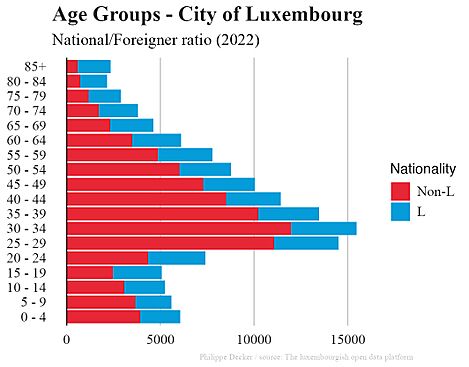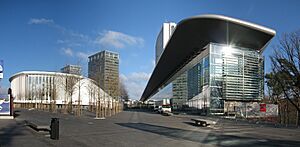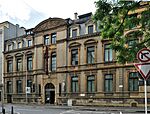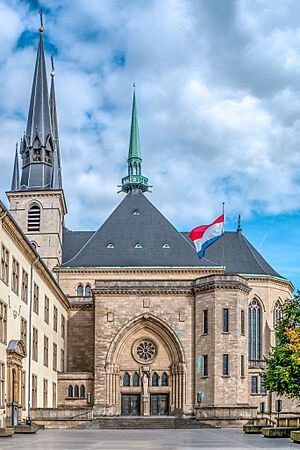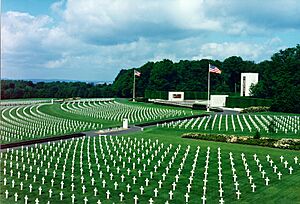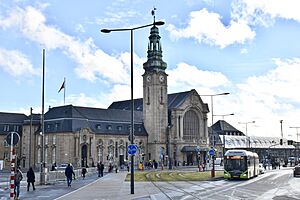Luxembourg City facts for kids
Quick facts for kids
Luxembourg
|
|||||
|---|---|---|---|---|---|
|
Capital city and commune
|
|||||
| Stad Lëtzebuerg | |||||
|
View of the Ville Haute, including the Fortress of Luxembourg, Notre-Dame Cathedral and the City History Museum
Grand Ducal Palace
Luxembourg tram
Place d'Armes
Schueberfouer
Kirchberg
|
|||||
|
|||||

Map of Luxembourg with Luxembourg City highlighted in orange, and the canton in dark red
|
|||||
| Country | Luxembourg | ||||
| Canton | Luxembourg | ||||
| Area rank | ? of 100 | ||||
| Highest elevation | 402 m (1,319 ft) | ||||
| • Rank | 48th of 100 | ||||
| Lowest elevation | 230 m (750 ft) | ||||
| • Rank | 42nd of 100 | ||||
| • Rank | 1st of 100 | ||||
| • Density rank | 91st of 100 | ||||
| Time zone | UTC+01:00 (CET) | ||||
| • Summer (DST) | UTC+02:00 (CEST) | ||||
| LAU 2 | LU0000304 | ||||
| Website | vdl.lu | ||||
| Click on the map for a fullscreen view | |||||
Luxembourg City is the capital of the country Luxembourg. It is also the largest city in the country. The city sits where the Alzette and Pétrusse rivers meet in southern Luxembourg. It is located in the heart of Western Europe.
Luxembourg City is about 213 kilometers (132 miles) from Brussels. It is also 209 kilometers (130 miles) from Cologne. The city grew around Luxembourg Castle, which was built by the Franks a long time ago.
As of December 31, 2024, Luxembourg City has 136,208 people living there. This is more than three times the population of the country's second-largest city, Esch-sur-Alzette. People from 160 different countries live in Luxembourg City. About 70% of the people are from other countries, while 30% are Luxembourgers. The number of people born outside Luxembourg keeps growing each year.
In 2024, the IMF said Luxembourg had the highest GDP per person in the world. GDP per person means the average amount of money earned by each person in a country. The city has become a major center for banking and business. In 2019, a survey ranked Luxembourg first for personal safety. It was also ranked 18th for overall quality of life.
Luxembourg City is one of the main cities for the European Union (EU). Other important EU cities are Brussels, Frankfurt, and Strasbourg. Many important EU offices are located here. These include the Court of Justice of the European Union and the European Court of Auditors. The European Investment Bank is also in Luxembourg City. The Council of the European Union holds meetings in the city for three months every year.
Contents
History of Luxembourg City
Long ago, during the Roman Empire, a strong tower stood where Luxembourg City is now. This tower protected a place where two Roman roads crossed. In 963, a man named Siegfried I got the land of Luxembourg. He was related to King Louis II of France and Emperor Otto the Great.
Siegfried built his castle, called Lucilinburhuc (meaning "small castle"), on a rock known as the Bock. This castle was first mentioned in the year 963. In 987, a church was built nearby, and a marketplace grew around it. This is how the city started to develop.
A Strong Fortress City
Because of its location, Luxembourg City has always been important for military defense. The first walls were built in the 900s. By the late 1100s, the city grew, and new walls were added. These walls protected an area of about 5 hectares (12 acres). Around 1340, under John the Blind, even stronger walls were built. These walls stayed until 1867.
Over the centuries, many different groups ruled Luxembourg. These included the Burgundians, the Spanish, the French, the Austrians, and the Prussians. Each ruler made the Luxembourg Castle stronger. By the 1500s, it was one of the strongest fortresses in Europe.
In the 1600s, the first casemates were built. These were underground tunnels for defense. Spain started building 23 kilometers (14 miles) of tunnels in 1644. The French military engineer Marshal Vauban later made them even bigger. The Austrians added more tunnels in the 1730s and 1740s.
The "Gibraltar of the North"
During the French Revolutionary Wars, France took over the city twice. The second time, Luxembourg City was under a siege for seven months. It held out for so long that a French leader called it "the best fortress in the world, except Gibraltar." This is how Luxembourg City got its nickname: the 'Gibraltar of the North'.
Eventually, the Austrian soldiers defending the city gave up. Luxembourg became part of France. After the Napoleonic Wars ended in 1815, Luxembourg City was controlled by Prussian soldiers. However, the country of Luxembourg was linked to the United Kingdom of the Netherlands.
Becoming Truly Independent
In 1867, after a disagreement called the Luxembourg Crisis, a treaty was signed. This treaty said that Luxembourg had to tear down its strong fortifications. It took sixteen years and a lot of money to destroy over 24 kilometers (15 miles) of underground defenses. The Prussian soldiers also had to leave.
In 1890, Grand Duke William III died without a male heir. This meant Luxembourg was no longer linked to the Netherlands. It became a truly independent country under Grand Duke Adolphe. Luxembourg City then became the capital of this new, independent nation.
World Wars and European Union
During World War I, Germany occupied Luxembourg starting in August 1914. The German army stayed for four years. In 1918, after the war, there was a brief attempt to create a socialist republic in Luxembourg City, but it only lasted a few hours.
In 1921, Luxembourg City grew much larger. Several nearby towns like Eich and Hollerich became part of the city. This made Luxembourg City the biggest city in the country until 1978.
In World War II, Germany occupied Luxembourg again in 1940. The Nazis changed the names of the city's streets to German names. For example, Avenue de la Liberté was renamed "Adolf-Hitlerstraße." Luxembourg City was freed on September 10, 1944. The city was attacked by German long-range cannons in late 1944 and early 1945.
After the war, Luxembourg decided not to be neutral anymore. It became a founding member of several international groups. In 1952, Luxembourg City became the main office for the High Authority of the European Coal and Steel Community. Even though this group later merged with other European bodies, Luxembourg City still hosts many important EU offices. These include the Court of Justice of the European Union and the European Investment Bank.
Geography of Luxembourg City
City Landscape
Luxembourg City is built on the southern part of the Luxembourg plateau. This area is made of sandstone and is part of the Gutland, a flatter region in the country.
The city center is very scenic. It sits high on steep cliffs that drop into the narrow valleys of the Alzette and Pétrusse rivers. These two rivers meet in Luxembourg City. Many bridges and viaducts cross the 70-meter (230-foot) deep gorges. Famous bridges include the Adolphe Bridge and the Grand Duchess Charlotte Bridge. The city's layout is complex because it is built on different levels, across hills and valleys.
The area of Luxembourg City is over 51 square kilometers (20 square miles). This makes it the fourth-largest city in Luxembourg by area. However, it is not very crowded, with about 1,700 people per square kilometer. Large parts of the city are parks, forests, or important historical sites, including UNESCO sites. There are also farms within the city limits.
City Neighborhoods
Luxembourg City is divided into twenty-four quarters. These quarters cover the entire city. They usually match the main neighborhoods and suburbs of Luxembourg City. Some older areas, like Bonnevoie, are split between two quarters.
City Climate
Luxembourg City has an oceanic climate. This means it has moderate rain, cool winters, and warm summers. It is cloudy for about two-thirds of the year.
People of Luxembourg City
| Historical population | ||||||||||||||||||||||||||||||||||||||||||||||||||||||||||
|---|---|---|---|---|---|---|---|---|---|---|---|---|---|---|---|---|---|---|---|---|---|---|---|---|---|---|---|---|---|---|---|---|---|---|---|---|---|---|---|---|---|---|---|---|---|---|---|---|---|---|---|---|---|---|---|---|---|---|
|
|
|||||||||||||||||||||||||||||||||||||||||||||||||||||||||
| Source: Le Portail des Statistiques du Luxembourg | ||||||||||||||||||||||||||||||||||||||||||||||||||||||||||
Government in Luxembourg City
Local City Government
Luxembourg City's local government is run by its communal council. This council has twenty-seven members. They are elected every six years in October and start their jobs on January 1st of the next year. This is the largest city council in Luxembourg. The Democratic Party (DP) is very strong in the city. They have provided the mayor since 1969. The DP has ten council members, making it the largest party on the council.
The city is led by the mayor. The mayor is the leader of the largest party on the communal council. Lydie Polfer (DP) became the new mayor on December 17, 2013. She had also been mayor from 1982 to 1999. The mayor leads a group called the College of Aldermen. In this group, the DP works with the CSV. Luxembourg City is allowed to have six aldermen, more than other cities in Luxembourg.
National Government
Luxembourg City is where the government of Luxembourg is located. The Grand Ducal Family of Luxembourg lives at Berg Castle in Colmar-Berg.
For national elections, the city is part of the Centre voting area.
European Union Institutions
Luxembourg City is home to many important offices and groups of the European Union. These include the Court of Justice of the European Union, parts of the European Commission, and the main office of the European Parliament. The European Court of Auditors and the European Investment Bank are also here. Most of these EU buildings are in the Kirchberg area, in the northeast of the city.
Culture in Luxembourg City
Even though the city is small, it has several interesting museums. These include the National Museum of History and Art (MNHA), the Luxembourg City History Museum, and the new Grand Duke Jean Museum of Modern Art (Mudam). There is also the National Museum of Natural History (NMHN).
Luxembourg was the first city to be named European Capital of Culture twice. The first time was in 1995. In 2007, it shared the title with the Romanian city of Sibiu. This event included parts of Germany, Belgium, and France. It was a way to encourage people to share ideas and cross borders in many ways.
Luxembourg City is also known for its many restaurants. Some of them have received special awards, like Michelin stars.
UNESCO World Heritage Site
The city of Luxembourg is on the UNESCO World Heritage List. It is called City of Luxembourg: its Old Quarters and Fortifications. This is because its old defense structures are very important historically.
The city has two main theaters: the Grand Théâtre de Luxembourg and the Théâtre des Capucins. There is also a modern concert hall called the Philharmonie. The conservatory has a large auditorium for music. Art galleries include the Villa Vauban, the Casino Luxembourg, and Am Tunnel. Most of these sites are in the Ville Haute (Upper City).
Sports in Luxembourg City
The ING Europe Marathon has been held in the capital every June since 2006. In 2014, 11,000 runners and over 100,000 people watched the race.
The Luxembourg Open is a tennis tournament held in the capital since 1991. It usually takes place in October.
The Stade de Luxembourg, located in Gasperich, is the country's national stadium. It is the largest sports place in Luxembourg. It can hold 9,386 people for sports like football and rugby. For concerts, it can hold 15,000 people. The largest indoor sports place is d'Coque in Kirchberg. It can hold 8,300 people. D'Coque is used for basketball, handball, gymnastics, and volleyball. It also has an Olympic-size swimming pool.
The city has two main football clubs: Racing FC Union Luxembourg and F.C. Luxembourg City. They play in the country's top football leagues. The Stade de Luxembourg is where the Luxembourg national football team plays its games.
Places to Visit
Some interesting places to visit include the Gothic Revival Cathedral of Notre Dame. You can also see the old fortifications and the underground art gallery called Am Tunnel. Other popular spots are the Grand Ducal Palace, the Gëlle Fra war memorial, and the casemates. The Neimënster Abbey, the Place d'Armes, the Adolphe Bridge, and the city hall are also worth seeing. The city is home to the RTL Group, a big media company.
The Luxembourg American Cemetery and Memorial from World War II is in Hamm, within the city limits. This cemetery is where 5,076 American soldiers are buried, including General George S. Patton. There is also a memorial for 371 Americans whose bodies were never found.
Getting Around Luxembourg City
Highways and Roads
Luxembourg City is in the center of Europe. It is connected to many major highways and international routes. These roads link it to cities like Frankfurt, Paris, and Amsterdam.
- A1 (E44): goes to Grevenmacher and Trier (Germany).
- A3 (E25): goes to Dudelange and Thionville (France).
- A4: goes to Esch-sur-Alzette and connects to A13 to Pétange, Athus (Belgium) and Longwy (France).
- A6 (E25 / E411): goes to Arlon and Brussels.
- A7 (E421): goes to Mersch and Ettelbruck.
Public Transportation
Since 2020, public transport in Luxembourg City has been free. This includes trains, buses, and trams.
Trains
Luxembourg City has five train stations. They are run by the national train company, the Société Nationale des Chemins de Fer Luxembourgeois (CFL). The main station, Luxembourg station, is where all train lines in the country end. Trains from Luxembourg City go to other places in Luxembourg. International trains also run from here, operated by CFL and companies from Germany, Belgium, and France. Luxembourg station is also connected to high-speed train lines to Paris and Strasbourg. You can also take trains to Basel and Zürich in Switzerland.
Buses
Luxembourg City has a network of 40 bus routes. These are run by the city's transport authority, Autobus de la Ville de Luxembourg (AVL). Some routes are run by private bus companies. There is a free bus that connects the Glacis area to Luxembourg station. There is also a "Joker Line" for seniors and a "City night network." The city also has "Park & Ride" areas where you can park your car and take a bus. Besides AVL buses, CFL and RGTR run regional buses to other towns in Luxembourg and nearby cities in Germany and France.
Trams
From 1875 to 1964, Luxembourg City had a large tram network. In December 2017, trams were brought back to the city. A new line opened in stages and was completed in March 2025. This line runs between Luxembourg Airport and Gasperich, passing through the city center. By 2035, the tram network is expected to have four lines.
Air Travel
Luxembourg City is served by the only international airport in the country: Luxembourg Airport (LUX). The airport is in the town of Sandweiler, about 6 kilometers (4 miles) from the city center. You can get to the airport by city bus, and a tram connection was completed on March 2, 2025. The airport is the main base for Luxembourg's airline, Luxair, and one of the world's largest cargo airlines, Cargolux.
International Connections
Luxembourg is part of the QuattroPole group of cities. This group includes Trier (Germany), Saarbrücken (Germany), and Metz (France).
Twin Cities
Luxembourg City is twinned with:
Images for kids
-
The Gëlle Fra monument commemorates those who volunteered for service in the armed forces of the Entente.
See also
 In Spanish: Luxemburgo (ciudad) para niños
In Spanish: Luxemburgo (ciudad) para niños
- Cessange
- Eurovision Song Contest 1962
- Eurovision Song Contest 1966
- Eurovision Song Contest 1973
- Eurovision Song Contest 1984
- Limes Luxemburgensis
- List of mayors of Luxembourg City
- Strassen, Luxembourg


